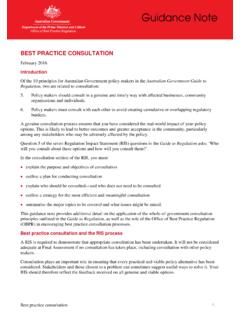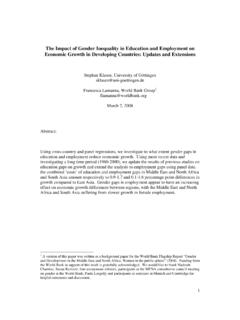Transcription of Australia’s 2030 Emission Reduction Target
1 S 2030 Emission Reduction TargetStrong, credible, responsibleThe Australian Government will reduce greenhouse gas emissions to 26 28 per cent below 2005 levels by 2030. Our Target is a step up from Australia s current Target to reduce emissions to five per cent below 2000 levels by s 2030 Target is a strong, credible and responsible contribution to climate action, as countries work to conclude a new global agreement at the Paris climate change conference in December 2015. It builds on Australia s impressive track record of addressing climate change and is consistent with strong growth in the economy and jobs. The Target has been set following wide public consultation and consideration of Australia s national circumstances. 498 submissions were received as a part of the Government s consultation on the Target .
2 An overwhelming majority wanted the Government to take action. Most submissions from business and industry called for a Target that sees Australia doing its fair share, in line with the actions of others and our national circumstances. The Government has chosen a 2030 Target to provide long term certainty to business. Australia will meet its 2030 Target through policies built on the proven Direct Action approach, which improve productivity, reduce costs and drive innovation such as the Emissions Reduction Fund, its Safeguard Mechanism and other complementary policies. Australia is also playing a significant role through practical actions to reduce emissions and improve the environment in the Asia-Pacific and in partnership with other countries. Photo: (top) River red gums in the Barmah State Forest (John Baker), (right) Solar powered house (Michelle McAulay) Australia has a strong track record on climate changeAustralia outperformed its Kyoto Protocol first commitment period Target (2008 2012) and is on track to meet and beat its 2020 2000 and 2013 the economy grew by nearly 50 per cent and our population grew strongly, while greenhouse gas emissions fell by two per cent.
3 Australia s emissions per capita have declined by 19 per cent since 2000 and by 22 per cent since 2005. Emissions per unit of gross domestic product have fallen by 33 per cent since 2000 and by 28 per cent since 1. Australia grows, emissions intensity and emissions per capita fall. 2. How Australia will meet its 2030 targetTo deliver significant emissions reductions the Government is implementing a suite of Direct Action policies, including the $ billion Emissions Reduction Fund and Safeguard Mechanism. The world-leading Emissions Reduction Fund has already purchased 47 million tonnes of emissions reductions. Overall design of Australia s 2030 Target policy framework will be further considered in detail in 2017 2018. At that time, lessons from implementation of the Emissions Reduction Fund will be the interim, the Government will consult on, and in some cases implement, initiatives that can deliver low cost emissions reductions and other co-benefits.
4 These include: a National Energy Productivity Plan, developed with the Council of Australian Governments Energy Ministers improving the efficiency of vehicles phasing down hydrofluorocarbons, which are used in refrigerators and air conditioners developing a strategy to improve the utilisation of solar power developing a low emissions technology roadmap. These measures align with other policies delivering significant emissions reductions, including: the Renewable Energy Target , which will deliver more than 23 per cent of Australia s electricity from renewables by 2020 Minimum Energy Performance Standards for appliances and buildings the 20 Million Trees 2. Australia s 2030 Target is achievable using Direct Action approaches. Technology improvements and other sources of abatement include technology innovation and breakthroughs, and other action by businesses, governments and the : Department of the Environment; chart represents indicative estimates.
5 Actual emissions reductions will depend on final policy design, and the amount of emissions reductions required to meet Australia s 2030 Target will depend on future emissions trends. The Government s reform agenda: lower taxes; less regulation; investing in small business and productive infrastructure; and returning the budget to surplus will keep our economy strong and jobs growing. This is central to attracting investment in new will be critical in achieving low cost emissions reductions. The Australian Government s Industry, Innovation and Competitiveness Agenda is implementing a wide range of actions to build business capability and better facilitate commercialisation by : Soil carbon (Andy Heaney) Government is already providing around $1 billion to new and innovative renewable energy, energy storage and energy efficiency technologies.
6 It will focus support on new and emerging technologies like large scale solar and battery Government is focussed on improving scientific understanding of climate change impacts and adaptation. This includes the National Environmental Science programme, National Climate Change Adaptation Research Facility and work to improve the environmental health of the Great Barrier Reef. 3. Australia s 2030 Target is strong, responsible and achievable Over 50 countries have now submitted targets. These countries make up around 60 per cent of global emissions, over 70 per cent of global GDP and 80 per cent of Australian two-way trade. In absolute terms Australia s Target sits within the range of efforts by other major economies. In terms of Reduction in emissions per capita and the emissions intensity of the economy, Australia s emissions intensity and emissions per person fall faster than many other economies.
7 Australia s emissions per person falls by 50 52 per cent between 2005 and 2030 and emissions per unit of GDP by 64 65 per 3. Australia s Target is in line with other countries targets1. Source: Department of the Environment analysis1 Note: China s emissions are based on OECD projections for GDP and assume China meets the upper bound of its emissions commitment. Figure 4. Change in Emissions Intensity 2030 Target Relative to 2005. Source: Department of the Environment, GDP data from Commonwealth of Australia 2014 -15 Budget and OECD database ( 2014 ) Note: For the purposes of this chart the US 2025 Target has been extrapolated to 2030 by extending a straight line of its Reduction from 2020 to 5. Change in Emissions Per Person 2030 Target Relative to 2005 : Department of the Environment; Population from Commonwealth of Australia, 2015 16 Budget (Australia) and UN World Population Database (other countries)Note: For the purposes of this chart the US 2025 Target has been extrapolated to 2030 by extending a straight line of its Reduction from 2020 to Reducing emissions with a growing economy and populationOur population and economy are growing faster than most other developed countriesCountries emissions are linked with population and economic Australian population continues to grow at a rate of around per cent a year to 2030, significantly higher than the OECD average of per cent.
8 This will push up our emissions. The Australian economy is in its 25th consecutive year of growth and is forecast to grow further over the next few years. This is the second longest continuous period of growth of any advanced economy in the world. Australia is continuing to grow while decreasing the emissions intensity of the economy. s exports are heavily based in emissions intensive resources and agricultural products In 2013 around half of Australia s exports were resources, with agriculture responsible for an additional 12 per cent. The majority of exports from other developed countries, apart from New Zealand, are manufacturing and services. Australia s exports of liquefied natural gas also play a role in supporting cleaner pathways by other countries. Figure 6. Export shares by : DFAT 2014 , Composition of Trade Australia 2013 (Australia), World Trade Organisation Statistics Database (other countries)More of Australia s electricity is generated from coalAustralia s electricity generation has been dominated by coal, which is cheap and accessible.
9 This has underpinned Australia s economic development. This does, however, create real challenges to reduce emissions without adversely impacting on the 2014 , coal fired electricity provided more than 60 per cent of Australia s total electricity supply, with more than 75 per cent of electricity produced from coal in the mainland eastern states of Queensland, New South Wales and Victoria. In comparison, in 2014 coal was responsible for about 25 per cent of electricity in the European Union and less than 40 per cent in the United States of America. Nuclear and gas make up a higher proportion of electricity generation in these economy and jobs will continue to growThe economic impacts are manageable and the economy will continue to grow. Our Target provides certainty and is set sufficiently far in advance to allow for a smooth transition.
10 Technological progress continues to be made in relation to energy and emissions efficiency. Choosing low cost policy options and acting in concert with others means we can contribute while remaining competitive and protecting our economy and jobs. 5. Australia s international roleClimate change is a global issue. All countries must work together to address it. The Australian Government is playing a constructive role in negotiations for a new global climate change agreement which will be finalised in December 2015 at the United Nations Framework Convention on Climate Change (UNFCCC) Conference of the Parties in Paris. Countries have agreed to a collective goal of limiting global average temperature rise to less than 2 C above pre-industrial levels. Effective global action towards meeting this goal will reduce climate risks to Australia s environment and economy.












